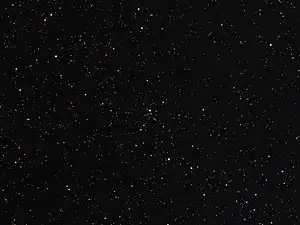| NGC 433 | |
|---|---|
 | |
| Observation data (J2000 epoch) | |
| Right ascension | 01h 15m 12.0s[1] |
| Declination | +60° 08′ 00″[1] |
| Distance | 6.5 kly (2.0 kpc)[1] |
| Physical characteristics | |
| Mass | 479+810 −301[2] M☉ |
| Estimated age | 65[2] Myr |
| Other designations | C 0112+598, OCISM 71, OCl 319, [KPR2004b] 16, [KPS2012] MWSC 0110.[3] |
| Associations | |
| Constellation | Cassiopeia |
NGC 433 is an open cluster in the northern constellation of Cassiopeia, located at a distance of 6,500 light years from the Sun.[1] It was discovered on September 29, 1829 by John Herschel, and was described by John Dreyer as "cluster, small, a little compressed."[4] The cluster is considered on the poor side, with only 12 stars above magnitude 16.[5] It has a linear diameter of 26.3 ly, with around 479 times the mass of the Sun and an age of 65 million years.[2]
References
- 1 2 3 4 Kharchenko, N. V.; et al. (2005). "Astrophysical parameters of Galactic open clusters". Astronomy and Astrophysics. 438 (3): 1163–1173. arXiv:astro-ph/0501674. Bibcode:2005A&A...438.1163K. doi:10.1051/0004-6361:20042523. S2CID 9079873.
- 1 2 3 Joshi, Y. C.; et al. (October 2016). "Study of open clusters within 1.8 kpc and understanding the Galactic structure". Astronomy & Astrophysics. 593: 13. arXiv:1606.06425. Bibcode:2016A&A...593A.116J. doi:10.1051/0004-6361/201628944. S2CID 118610932. A116.
- ↑ "NGC 433". SIMBAD. Centre de données astronomiques de Strasbourg. Retrieved April 19, 2017.
- ↑ "New General Catalog Objects: NGC 400 - 449". Cseligman. Retrieved April 19, 2017.
- ↑ Battinelli, P.; et al. (May 1992). "CCD Photometric and Spectroscopic Observations of the Young Open Cluster NGC 433". Astronomical Journal. 103: 1596. Bibcode:1992AJ....103.1596B. doi:10.1086/116172.
This article is issued from Wikipedia. The text is licensed under Creative Commons - Attribution - Sharealike. Additional terms may apply for the media files.